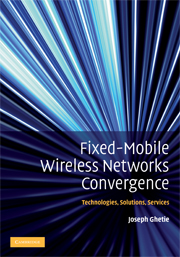Book contents
- Frontmatter
- Contents
- Disclaimer
- How the Book is Organized
- List of Figures
- List of Tables
- Preface
- Acknowledgments
- Acronyms
- Part I Wireless Communications: Networking and Management
- Part II Cellular Mobile Radio Networking and Management
- Part III Fixed Wireless Technologies: Networking and Management
- 6 Wireless Local Area Networking
- 7 Wireless Personal Area Networking
- 8 Wireless Metropolitan Area Networking
- 9 Wireless Near-Field Sensor Networking
- Part IV Fixed Wireless Cellular Mobile Networks Convergence and Integration
- Part V Fixed Wireless Cellular Mobile Networks Convergence: Standardized Networking Solutions
- Part VI Fixed-Mobile Convergence Services, Industry Trends, and Implementation Issues
- References
- Index
8 - Wireless Metropolitan Area Networking
from Part III - Fixed Wireless Technologies: Networking and Management
Published online by Cambridge University Press: 21 August 2009
- Frontmatter
- Contents
- Disclaimer
- How the Book is Organized
- List of Figures
- List of Tables
- Preface
- Acknowledgments
- Acronyms
- Part I Wireless Communications: Networking and Management
- Part II Cellular Mobile Radio Networking and Management
- Part III Fixed Wireless Technologies: Networking and Management
- 6 Wireless Local Area Networking
- 7 Wireless Personal Area Networking
- 8 Wireless Metropolitan Area Networking
- 9 Wireless Near-Field Sensor Networking
- Part IV Fixed Wireless Cellular Mobile Networks Convergence and Integration
- Part V Fixed Wireless Cellular Mobile Networks Convergence: Standardized Networking Solutions
- Part VI Fixed-Mobile Convergence Services, Industry Trends, and Implementation Issues
- References
- Index
Summary
Wireless MAN Technologies
Wireless Metropolitan Area Network (WMAN), like WLAN and WPAN, is a generic term for networking confined to a geographical area and a set of specific networking technologies that provide wireless communications in metropolitan areas. WMAN is a new technology that will be a supplement to well-known wired technologies such as Resilient Packet Ring (RPR), Synchronous Optical Network/Synchronous Digital Hierarchy (SONET/SDH), SONET over IP, Gigabit Ethernet, and Wavelength Division Multiplexing (WDM). The area of coverage of WMAN falls between WLAN/WPAN, which are customer premises networks, and Wireless Wide Area Networks (WWAN), which are associated with cellular radio mobile networks. Methods of access to WMANs have some resemblance to those of broadband wired access technologies such as Digital Subscriber Line (DSL) and Data over Cable Service Interface Specifications (DOCSIS).
Conceptually, WMAN networks provide services to metropolitan or regional areas, either urban or rural, within a radius of 50 km. They can be used to connect WLANs/WPANs and provide access to data, voice, video, and multimedia services. Although WMANs provide city-wide coverage, the area may be as small as a university campus or even a group of buildings. WMANs belong to a network operator or a service provider, in many cases a wireless extension of services provided by wired or wireless carriers. WMANs can be implemented using a variety of wireless technologies: Local Multipoint Distributed Service (LMDS), Multi-Channel Multipoint Distributed Service (MMDS), Free Space Optics (FSO), Wireless Local Loop (WLL), and Wireless Interoperable Metropolitan Area Exchange (WiMAX).
- Type
- Chapter
- Information
- Fixed-Mobile Wireless Networks ConvergenceTechnologies, Solutions, Services, pp. 172 - 190Publisher: Cambridge University PressPrint publication year: 2008



